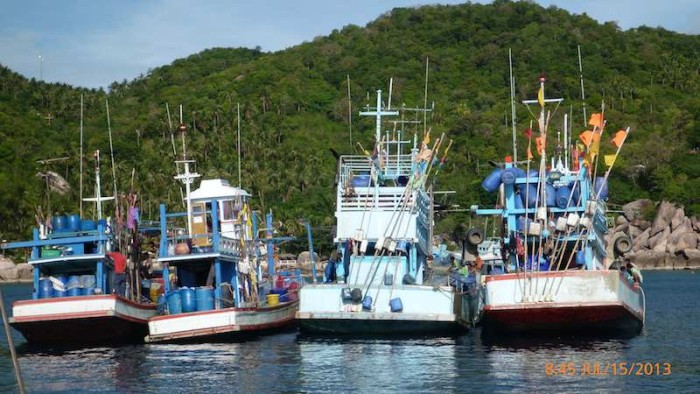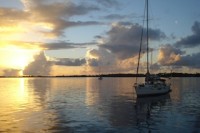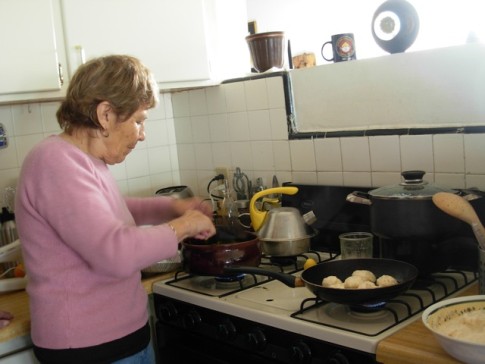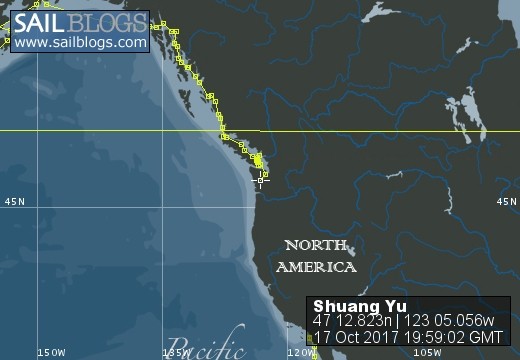
Joy of Cruising
17 October 2017 | Boat position at Shelton: 47°12.82’N; 123°05.01’W
16 October 2017 | Boat position at Shilshole Marina: 47°40.65’N; 122°24.59’W
15 October 2017 | Boat position at Friday Harbor: 48°32.20’N; 123°0.59’W
27 September 2017 | Boat position on Granville Island: 49°16.35’N; 123°08.24’W
26 September 2017 | Boat position on Granville Island: 49°16.35’N; 123°08.24’W
22 July 2017 | Boat position at Granville Island: 49°16.35’N; 123°08.24’W
21 July 2017 | Boat position at Vancouver Rowing Club, Canada: 49°17.77’N; 123°07.85’W
20 July 2017 | Boat position at the Vancouver Rowing Club, Canada: 49°17.77’N; 123°07.85’W
19 July 2017 | Boat position at the Vancouver Rowing Club: 49°17.77’N; 123°07.85’W
18 July 2017 | Boat position in Active Pass: 48°51.64’N; 123°18.54’W
17 July 2017 | Boat position at Otter Cove, Pender Island, Canada: 48°47.84’N; 123°18.51’W
15 July 2017 | Boat position at Port Bedwell, Pender Island, Canada: 48 44.97'N; 123 13.97'W
14 July 2017 | Boat position at RVYC: 48 27.19'N; 123 17.73'W
13 July 2017 | Boat position at RVYC: 48 27.19'N; 123 17.73'W
12 July 2017 | Boat position at SNSYC: 48 40.44'N; 123 25.02'W
12 July 2017 | Boat position at SNSYC: 48 40.44'N; 123 25.02'W
11 July 2017 | Boat position at SNSYC: 48 40.44'N; 123 25.02'W
10 July 2017 | Boat position at Ganges: 48 51.00'N; 123 29.53'W
09 July 2017 | Boat position at Ganges: 48 51.00'N; 123 29.53'W
08 July 2017 | Boat position at Montague Harbour: 48 53.63'N; 123 24.03'W
Koh Tao to Koh Samui
18 July 2013 | Boat position at Koh Phangnan, Thailand: 09°46.40’ N; 100°03.40’E
Pam Lau

Picture: Fishing boats rafted together, notice the tall and skinny nature of the boats. The flags on the back are used for marking fish traps in the ocean and can be a danger to other shipping.
The night before we left Koh Tao, we told Ting, the resort owner that we were leaving in the morning and he said the wind tomorrow would get up to about 60 knots (69 mph or 111 kph). We have never experienced 60 knots and thought maybe something got lost in translation and he really meant 16 knots. We thought no more about it because our own forecasts obtained through sailmail said about 16 knots. Next morning three sailboats, including us, took off around 08:00. John and Shelly, the chefs, were the first ones to leave the anchorage, heading to Koh Samui because their boat was due back to the charter company the next morning. They had both their sails up and they were flying. As soon as we were out of the bay, we could feel a healthy southwesterly wind so we unfurled our genoa. We were cruising around 5 to 7 knots without the main sail for about three hours. Koh Phangnan, our next destination, was in sight, about four nautical miles away.
It was one of those perfect sailing days - then the wind changed to west, our starboard side. We quickly pulled the genoa in because the wind was escalating and the sea rising higher and higher as if trying to push us over. Ted ordered me to go below and close all hatches, including the main companionway, the “door” to downstairs. It was humid and airless in the cabin and the sea was rough. I had to look out of one of the side windows and watch the waves heave up and down so I would not be seasick. Ted was at the helm trying to keep “Shuang Yu” on course and upright as it was too rough for the autopilot. As Ting had predicted, the wind got up to 60 knots per hours for about 20 minutes, but it seemed like an eternity. We could not go into the wind because we had nowhere near enough engine power so we had to turn tail and run with the wind even though it was in the wrong direction. Side on (beam on) was not an option as we would have capsized. At least we had plenty of sea room as there were no islands or rocks downwind. Ted kept the engine running but left the gearbox in neutral. We could see fishing boats steaming towards the shelter of Koh Phangnan at full speed. We did not know they could go so fast, but I guess they have very powerful engines since they pull huge nets when they are fishing. At the height of the storm we passed one fishing boat with its anchor down at 150 feet (about 50 meters), it was really being tossed around but its bow was pointing towards the wind and swell most of the time. The wind dropped to 40 knots but we still could not go into the wind or even beam on. When the wind dropped to about 30 knots we turned around and started heading towards our destination at between zero and 1 knot, less than 1 nautical mile per hour. We were off course by at least three nautical miles by that time. It seemed like a short distance but it took “Shuang Yu” two or three hours to get to the sheltered anchorage, by which time the wind had dropped to almost nothing. We thank our lucky stars that we made it to safety. That was one of our scariest sailing experiences. We hope the other two yachts made it OK; we had the radio on and heard no “mayday” calls.
The sailing pilot book suggests yachts should anchor on the south side of the bay because it is more protected from the southwesterly monsoon winds. We tried to anchor there but dragged and got very close to fishing boats rafted together nearby. We moved to the north end of the bay where there were fewer vessels. The wind got up again at night but only about 20 or 30 knots. The next morning, we saw a fishing boat turned upside down inside the bay, leaving only the wooden side and part of the top deck showing. It was still floating because they are made of timber in this part of the world. We were not surprised that it turned over because they seem very high and top heavy for their beam (width). We did not see it when we arrived the day before so it probably overturned at sea during yesterday’s storm and got towed into the bay. Just before we left the anchorage the following day, we saw boats on each side of the sunken boat and men were working on the exposed part. Ting, the owner of “View Rock” at Koh Tao, told us of a similar incident near his resort. He said they turned the boat right side up with ropes and then pumped the water out. The boat was back in service in no time. We are not sure how they got the big diesel engine running again, maybe they took it apart, cleaned and dried every bit and re-assembled it again. The electrics would not be much good though!
We motored most of the way from Koh Phangnan to Koh Samui. Unlike the last lag, the sea was as flat as a tack and we had a soft breeze. We passed an anchorage called Haad Rin (09º40.35’N, 100º04.15’E), the famous “Full Moon Party” beach. There were some high-rise hotel buildings on the island, amazing development. Of course they draw tourists, mostly young adults, to the place to drink, dance and play loud music all night long. One thing about being older - one gets wiser as well - not allowing ourselves to be lured into the “Full Moon Party” gimmick trap.
It felt comforting to be back to Koh Samui in familiar surroundings. However, despite the high winds, the experience of the previous week was well worth it. We really appreciated the beauty of the islands.
The night before we left Koh Tao, we told Ting, the resort owner that we were leaving in the morning and he said the wind tomorrow would get up to about 60 knots (69 mph or 111 kph). We have never experienced 60 knots and thought maybe something got lost in translation and he really meant 16 knots. We thought no more about it because our own forecasts obtained through sailmail said about 16 knots. Next morning three sailboats, including us, took off around 08:00. John and Shelly, the chefs, were the first ones to leave the anchorage, heading to Koh Samui because their boat was due back to the charter company the next morning. They had both their sails up and they were flying. As soon as we were out of the bay, we could feel a healthy southwesterly wind so we unfurled our genoa. We were cruising around 5 to 7 knots without the main sail for about three hours. Koh Phangnan, our next destination, was in sight, about four nautical miles away.
It was one of those perfect sailing days - then the wind changed to west, our starboard side. We quickly pulled the genoa in because the wind was escalating and the sea rising higher and higher as if trying to push us over. Ted ordered me to go below and close all hatches, including the main companionway, the “door” to downstairs. It was humid and airless in the cabin and the sea was rough. I had to look out of one of the side windows and watch the waves heave up and down so I would not be seasick. Ted was at the helm trying to keep “Shuang Yu” on course and upright as it was too rough for the autopilot. As Ting had predicted, the wind got up to 60 knots per hours for about 20 minutes, but it seemed like an eternity. We could not go into the wind because we had nowhere near enough engine power so we had to turn tail and run with the wind even though it was in the wrong direction. Side on (beam on) was not an option as we would have capsized. At least we had plenty of sea room as there were no islands or rocks downwind. Ted kept the engine running but left the gearbox in neutral. We could see fishing boats steaming towards the shelter of Koh Phangnan at full speed. We did not know they could go so fast, but I guess they have very powerful engines since they pull huge nets when they are fishing. At the height of the storm we passed one fishing boat with its anchor down at 150 feet (about 50 meters), it was really being tossed around but its bow was pointing towards the wind and swell most of the time. The wind dropped to 40 knots but we still could not go into the wind or even beam on. When the wind dropped to about 30 knots we turned around and started heading towards our destination at between zero and 1 knot, less than 1 nautical mile per hour. We were off course by at least three nautical miles by that time. It seemed like a short distance but it took “Shuang Yu” two or three hours to get to the sheltered anchorage, by which time the wind had dropped to almost nothing. We thank our lucky stars that we made it to safety. That was one of our scariest sailing experiences. We hope the other two yachts made it OK; we had the radio on and heard no “mayday” calls.
The sailing pilot book suggests yachts should anchor on the south side of the bay because it is more protected from the southwesterly monsoon winds. We tried to anchor there but dragged and got very close to fishing boats rafted together nearby. We moved to the north end of the bay where there were fewer vessels. The wind got up again at night but only about 20 or 30 knots. The next morning, we saw a fishing boat turned upside down inside the bay, leaving only the wooden side and part of the top deck showing. It was still floating because they are made of timber in this part of the world. We were not surprised that it turned over because they seem very high and top heavy for their beam (width). We did not see it when we arrived the day before so it probably overturned at sea during yesterday’s storm and got towed into the bay. Just before we left the anchorage the following day, we saw boats on each side of the sunken boat and men were working on the exposed part. Ting, the owner of “View Rock” at Koh Tao, told us of a similar incident near his resort. He said they turned the boat right side up with ropes and then pumped the water out. The boat was back in service in no time. We are not sure how they got the big diesel engine running again, maybe they took it apart, cleaned and dried every bit and re-assembled it again. The electrics would not be much good though!
We motored most of the way from Koh Phangnan to Koh Samui. Unlike the last lag, the sea was as flat as a tack and we had a soft breeze. We passed an anchorage called Haad Rin (09º40.35’N, 100º04.15’E), the famous “Full Moon Party” beach. There were some high-rise hotel buildings on the island, amazing development. Of course they draw tourists, mostly young adults, to the place to drink, dance and play loud music all night long. One thing about being older - one gets wiser as well - not allowing ourselves to be lured into the “Full Moon Party” gimmick trap.
It felt comforting to be back to Koh Samui in familiar surroundings. However, despite the high winds, the experience of the previous week was well worth it. We really appreciated the beauty of the islands.
Comments
| Vessel Name: | Shuang Yu |
| Vessel Make/Model: | Catalina 400 |
| Hailing Port: | San Diego |
| Crew: | Ted Berry and Pam Lau |
| Home Page: | www.sailblogs.com/member/tedandpam/ |
| Social: |

Who: Ted Berry and Pam Lau
Port: San Diego



